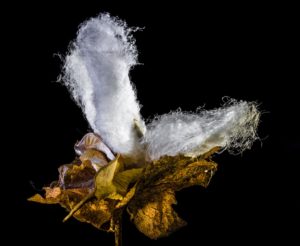 Cotton crops the world over have benefited from the pest-killing protein from Bacillus thuringiensis (Bt), first used in sprays and then, in 1996, transgenic crops, resulting in reduced insecticide use, enhanced biological control, and increased farmer profits. But the precious plants are under threat once again by a tiny but mighty pest: pink bollworm (Pectinophora gossypiella). In India, where more than 7 million farmers have planted 10.8 million hectares of transgenic Bt cotton, the lepidopteran pest has developed resistance to two different forms of the toxin that made the transgenic crops so effective, creating catastrophic economic losses.
Cotton crops the world over have benefited from the pest-killing protein from Bacillus thuringiensis (Bt), first used in sprays and then, in 1996, transgenic crops, resulting in reduced insecticide use, enhanced biological control, and increased farmer profits. But the precious plants are under threat once again by a tiny but mighty pest: pink bollworm (Pectinophora gossypiella). In India, where more than 7 million farmers have planted 10.8 million hectares of transgenic Bt cotton, the lepidopteran pest has developed resistance to two different forms of the toxin that made the transgenic crops so effective, creating catastrophic economic losses.
Scientists have been studying the genetics of this insecticide resistance in the lab to address the issue, but do their subjects truly represent the realities of rapid resistance evolution in the field?
An international team of scientists from Arizona, India and Australia set to find out, using targeted SMRT Sequencing to compare Bt resistant lab samples with those collected from cotton fields.
As described in Scientific Reports, they used SMRT Sequencing to analyze barcoded cDNA of 22 larvae from Arizona laboratory-selected strains and Indian field-selected populations of pink bollworms. The PacBio sequencing, conducted by our certified service provider the Arizona Genomics Institute, expanded upon knowledge gleaned from previous allele-specific PCR genotyping and revealed five previously unidentified transcript variants.
The research team, led in the United States by Jeffrey A. Fabrick and Lolita G. Mathew of the U.S. Department of Agriculture’s Arid Land Agricultural Research Center in Maricopa, AZ, were specifically looking for clues into resistance to the Bt toxin Cry2Ab.
Initial Bt cotton crops produced a single toxin from the Cry1 family, Cry1Ac, but at least eight major lepidopteran pests evolved resistance to the toxin in the field, so most Bt crops grown now also produce Cry2Ab. So far, only Indian pink bollworm and Helicoverpa zea in the United States have evolved resistance to Cry2Ab, and data on the genetic basis of Cry2Ab resistance are relatively scarce and limited to laboratory-selected strains.
The researchers found both similarities and differences in the lab- and field-selected strains. They discovered that mutations disrupting the ABC transporter gene PgABCA2 are associated with resistance to Cry2Ab in both. But only one specific mutation — mis-splicing that omits exon 6 and introduces a stop codon at amino acid 373 — was shared between the Arizona and India strains. The other mutations were mostly from splice-site mutations that lead to mis-splicing of PgABCA2, and were more diverse in India.
“The differences in PgABCA2 resistance mutations between India and Arizona could reflect the difference in geographic origin, laboratory versus field selection, or both,” wrote the authors. “The results suggest that focusing on ABCA2 may help to accelerate progress in monitoring and managing field-evolved resistance to Cry2Ab.”
The researchers also noted the benefits of PacBio sequencing for monitoring variants associated with resistance in the field.
Traditional PCR, cloning, and Sanger sequencing methods are laborious and not practical for monitoring the diverse mutations in the field, they wrote, but “this method allowed us to multiplex cDNA samples from 22 individuals and obtain sequencing information from essentially single molecules of full-length PgABCA2 cDNA without post-sequencing assembly.”
“Given that PgABCA2-mediated resistance to Cry2Ab occurred in pink bollworm populations from Arizona and India, long-read sequencing focusing on this gene could provide a valuable alternative to the F1 screen for monitoring resistance to Cry2Ab in this cosmopolitan pest,” they added.
December 10, 2018 | General